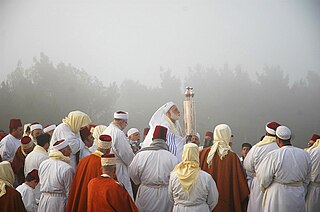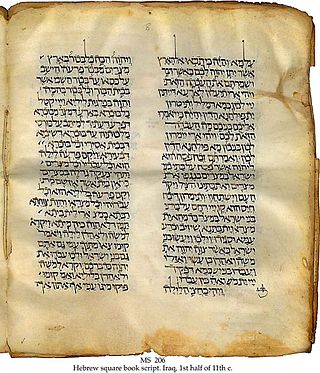Aramaic is a Northwest Semitic language that originated in the ancient region of Syria, and quickly spread to Mesopotamia, the southern Levant, southeastern Anatolia, Eastern Arabia and Sinai, where it has been continually written and spoken, in different varieties, for over three thousand years. Aramaic served as a language of public life and administration of ancient kingdoms and empires, and also as a language of divine worship and religious study. Several modern varieties, the Neo-Aramaic languages, are still spoken by the Assyrians, Mandeans, Mizrahi Jews, and in the towns of Maaloula and nearby Jubb'adin, in Syria. Aramaic is used as the liturgical language of a number of West Asian churches.

Samaritans, also known as Israelite Samaritans, are an ethnoreligious group who originate from the ancient Israelites. They are native to the Levant and adhere to Samaritanism, an Abrahamic ethnic religion similar to Judaism, but differing in several important aspects.

Samaria is the Hellenized form of the Hebrew name Shomron, used as a historical and biblical name for the central region of Israel, bordered by Judea to the south and Galilee to the north. The region is known to the Palestinians in Arabic under two names, Samirah, and Mount Nablus.

Judaism considers some names of God so holy that, once written, they should not be erased: יהוה, אֲדֹנָי (Adonai), אֵל, אֱלֹהִים, אֵל שַׁדַּי, שַׁדַּי, יְהֹוָ֥ה צְבָאֽוֹת and צְבָאֽוֹת ; some also include I Am that I Am. Early authorities considered other Hebrew names mere epithets or descriptions of God, and wrote that they and names in other languages may be written and erased freely. Some moderns advise special care even in these cases, and many Orthodox Jews have adopted the chumras of writing "G-d" instead of "God" in English or saying Ṭēt-Vav instead of Yōd-Hē for the number fifteen or Ṭēt-Zayin instead of Yōd-Vav for the Hebrew number sixteen.

A targum was an originally spoken translation of the Hebrew Bible that a professional translator would give in the common language of the listeners when that was not Biblical Hebrew. This had become necessary near the end of the first century BC, as the common language was Aramaic and Hebrew was used for little more than schooling and worship. The translator frequently expanded his translation with paraphrases, explanations and examples, so it became a kind of sermon.

The Samaritan Torah, commonly called the Samaritan Pentateuch, is a text of the Torah written in the Samaritan script and used as sacred scripture by the Samaritans. It dates back to one of the ancient versions of the Hebrew Bible that existed during the Second Temple period, and constitutes the entire biblical canon in Samaritanism.

Targum Onkelos is the primary Jewish Aramaic targum ("translation") of the Torah, accepted as an authoritative translated text of the Five Books of Moses and thought to have been written in the early second century CE.

Targum Jonathan, otherwise referred to as Targum Yonasan/Yonatan, is the official eastern (Babylonian) targum to the Nevi'im ("prophets").
Samaritan Hebrew is a reading tradition used liturgically by the Samaritans for reading the Ancient Hebrew language of the Samaritan Pentateuch, in contrast to Tiberian Hebrew among the Jewish people.

The Paleo-Hebrew script, also Palaeo-Hebrew, Proto-Hebrew or Old Hebrew, is the writing system found in inscriptions of Canaanite languages from the region of Southern Canaan, also known as biblical Israel and Judah. It is considered to be the script used to record the original texts of the Hebrew Bible due to its similarity to the Samaritan script, as the Talmud stated that the Hebrew ancient script was still used by the Samaritans. The Talmud described it as the "Libona'a script", translated by some as "Lebanon script". Use of the term "Paleo-Hebrew alphabet" is due to a 1954 suggestion by Solomon Birnbaum, who argued that "[t]o apply the term Phoenician [from Northern Canaan, today's Lebanon] to the script of the Hebrews [from Southern Canaan, today's Israel-Palestine] is hardly suitable". The Paleo-Hebrew and Phoenician alphabets are two slight regional variants of the same script.
Jewish commentaries on the Bible are biblical commentaries of the Hebrew Bible from a Jewish perspective. Translations into Aramaic and English, and some universally accepted Jewish commentaries with notes on their method of approach and also some modern translations into English with notes are listed.
The second death, also known as eternal death, is an eschatological concept in Judaism, Christianity, and Mandaeism related to punishment after a first/initial death on Earth.
Kinnot are Hebrew dirges or elegies. The term is used to refer both to dirges in the Hebrew Bible, and also to later poems which are traditionally recited by Jews on Tisha B'Av.

al-Badhan is a Palestinian village in the Nablus Governorate in the North central West Bank, located 7.28 kilometres (4.52 mi) northeast of Nablus, and 1.5 kilometres (0.93 mi) to the north of Elon Moreh. According to the Palestinian Central Bureau of Statistics (PCBS), the village had a population of 3,171 inhabitants in 2017.
Ze'ev Wolf Goldman, later known as Ze'ev Ben-Haim, was a leading Israeli linguist and a former president of the Academy of the Hebrew Language.

Targum Neofiti is the largest of the western or Palestinian Targumim on the Torah. The name derives from the ecclesiastical Latin word Neophyte because the owners of the earliest copy were converts from Judaism. The extant copy consists of 450 folios covering all books of the Torah, with only a few damaged verses.

Rudolf Macuch was a Slovak linguist, naturalized as German after 1974.
The Asaṭīr, also known as the Samaritan Book of the Secrets of Moses, is a collection of Samaritan Biblical legends, parallel to the Jewish Midrash, and which draws heavily upon oral traditions known among Jews in the 2nd and 3rd centuries CE. Moses Gaster places its compilation about the middle or end of the third century BCE, and rendered a translation of the work in 1927 with the Royal Asiatic Society in London. Others have said that its language style resembles more the Arabic language used by the scholar Ab Ḥisda [Isda] of Tyre in his poems of the eleventh century CE, and place its composition in the second-half of the tenth-century. The book's title, Asatir, was thought by Gaster to mean "secrets," from which name, he applied to the book its newer title, "The Secrets of Moses." Even so, such an interpretation has nothing to do with the contents of the book, nor with its subject. A more precise translation of the Arabic title of the work, al-Asāṭīr, would be "legends" or "tales," as in the Koranic expression asāṭīr al-Awwalīn.
Textual variants in the Book of Deuteronomy concerns textual variants in the Hebrew Bible found in the Book of Deuteronomy.









